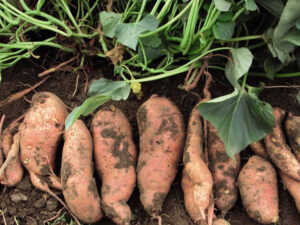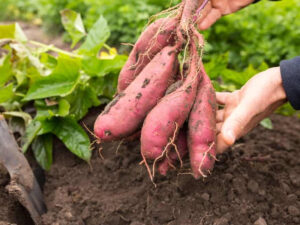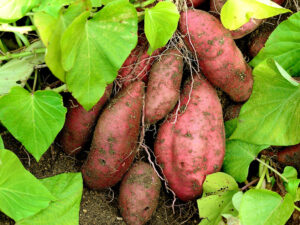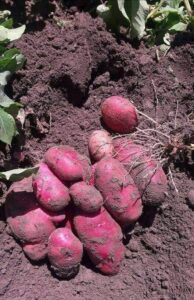Sweet potatoes are available in two varieties: Vining and bush. Both types thrive in the intense summer heat and, with the appropriate spacing and soil, are quite easy to cultivate. Sweet potatoes are grown from slips rather than seeds, as are most other vegetables.

Slips are sweet potato shoots that have matured. Learn how to cultivate sweet potatoes, when to harvest them, and how to cure them once they’ve been harvested.
You can start slips from a sweet potato you bought at the shop or one from your garden, or you can order slips from a mail order or Internet catalog. If you buy a potato from the supermarket, make sure to ask if it’s a bush or a vining kind.
Bush kinds are still vining but at a considerably shorter length than vining types. You’ll need several healthy, clean sweet potatoes to get started with your slips.
Up to 50 slip sprouts can be produced from a single sweet potato. To make sprouts, wash your potatoes thoroughly and cut them in half or large parts.

Place half of the potato below the water and half above it in a jar or glass of water. To keep the potato in place, use toothpicks.
Put the slips on a window ledge or on top of a radiator to keep them warm. Your potatoes will be covered with leafy sprouts on top and roots on the bottom in a few weeks.
You must split your sweet potatoes into plantable slips once they have sprouted. To accomplish this, carefully twist each sprouts away from the sweet potato.
Place each sprout in a shallow dish, with the bottom half of the stem submerged in water and the leaves dangling over the bowl’s lip.

Roots will sprout from the bottom of each new plant within a few days. When the roots are about one inch long, the young slips are ready to plant.
Maintain the water fresh and eliminate any slips that aren’t forming roots or appear to be withering to keep your slips healthy.
You’ll need to do a little extra work before planting sweet potato slips. To grow huge tubers, sweet potatoes need a soil that is loose and well-drained. When the roots try to expand within the soil, you don’t want them to encounter any obstacles.

When it comes to cultivating sweet potatoes successfully, loose soil is more important than nearly any other component. Plant with the roots pointing down in prepared soil.
Place the slip so that the bottom half is covered in mud and the top half, which contains all of the new leaves, is visible. Make sure the new plant isn’t bruised.
Sweet potatoes are sensitive to being ᴅᴀᴍᴀɢᴇd or banged around. To set the plant and remove any leftover air pockets, gently push the surrounding ground. Carry on in this manner until all of your slips have been planted.

Sweet potato plants swiftly spread and cover an area, rooting into the earth at leaf nodes. Bush varieties can grow to be 3 feet long, while vining varieties can grow to be 20 feet long.
Plants should be spaced appropriately. It’s commonly accepted that slips should be spaced 12-18 inches apart.
Once all of the slips are in place, water them. You’ll need to immerse them thoroughly until all of the earth around them is saturated. New plants, such as slips, require daily watering for the first week and every other day for the second week.

Waterings can be spaced out a little further each week until you’re just watering once a week. You may need to change this plan in your own garden if the ground is particularly dry or if there has been a lot of rain.
Sweet potatoes can endure drought, but they will produce less, so keep them well-watered throughout the hottest months of the year.

When you should harvest sweet potatoes depends on the variety you buy. It is critical to read the packaging when receiving your slips.
Most types mature in three to four months, or 90 to 120 days, however, there are several newer cultivars that mature faster and are produced expressly for short-season northern regions (Such as Georgia Jet, Vardaman, and Centennial).

In the video belᴏw, we’ll see Sweet Potato with Black Tea – A dried sweet potato and jasmine black tea is the simplest happiness.
Thank you for visiting our website! We hope you found something that sparked your interest on our website. Share this with your family and friends.
► YOU MAY ALSO LIKE:
The Secret of Grow And Harvest Lotus Seeds at Lake, Will Surprise

How To Grow And Harvest Rice From Seeds Will Surprise You That Few People Know About
Secrets Of Grow Chilies Farm For High Yield

The Secret of Greenhouse Eggplant Farm For High Yield
How To Grow Rice From Store-bought Brown Rice for High Yield

Grow and Harvest Giant Taro and Bring It To The Market To Sell
Thorny Temptations – Exploring the Alluring World of Prickly Fruits

The Secret of Planting And Harvesting Pears At Home Garden Efficiently And With High Yield

How To Farming Harvest China And Japan’s Giant Plum & Product Process

Setting New Size Records: Exploring The Astonishing Diversity Of Extraordinary Fruits And Vegetables





